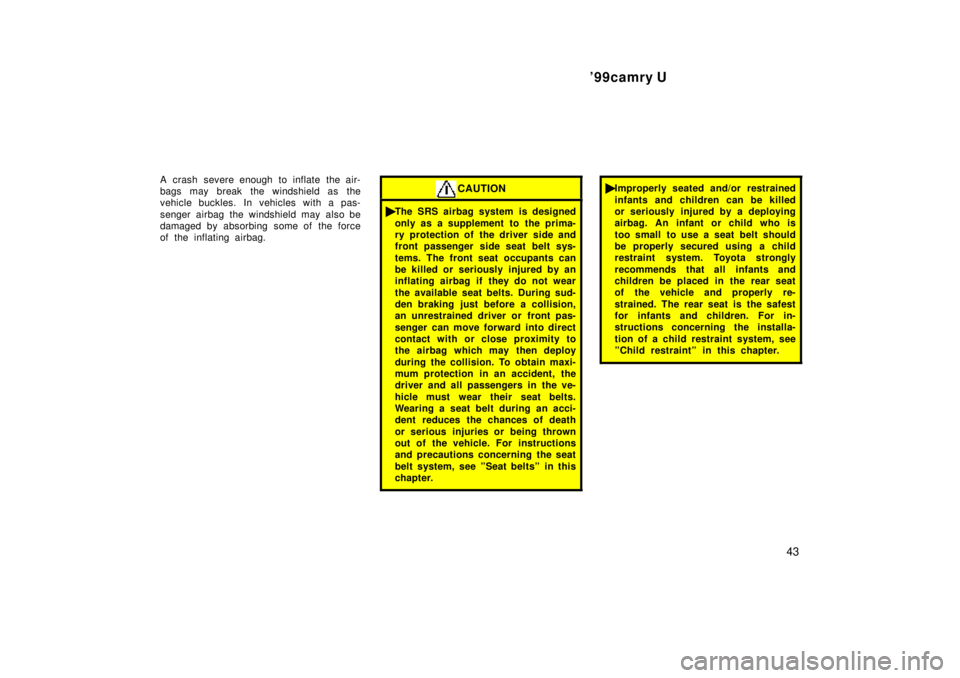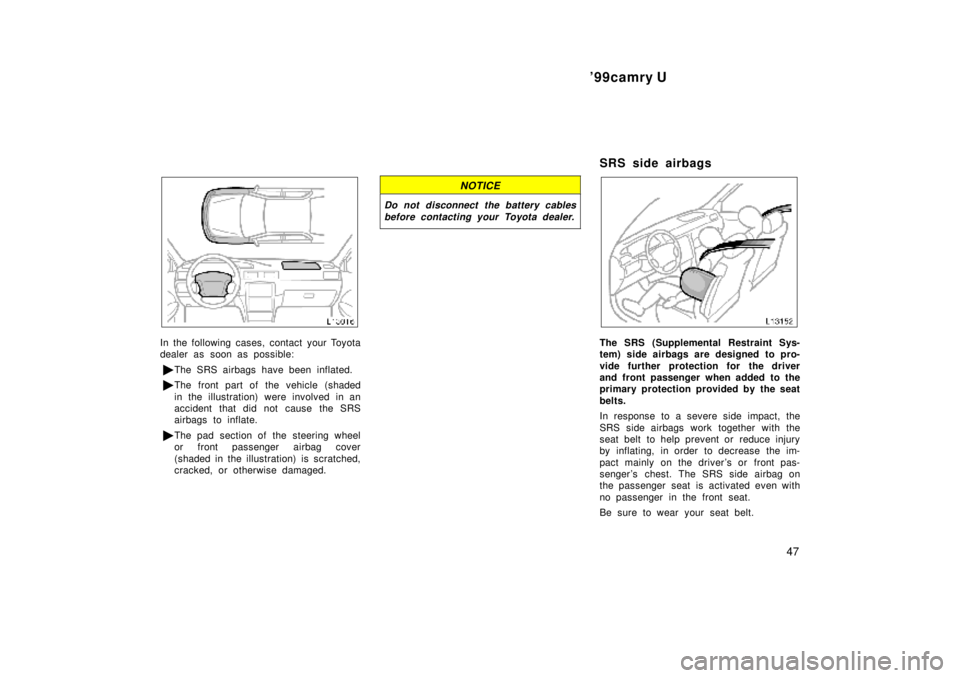Page 803 of 4770

'99camry U
37
To connect the extender to the seat
belt, insert the tab into the seat belt
buckle so that the ºPRESSº signs on
the buckle±release buttons of the ex-
tender and the seat belt are both facing
outward as shown.
You will hear a click when the tab locks
into the buckle.
When releasing the seat belt, press on
the buckle±release button on the extender,
not on the seat belt. This helps prevent
damage to the vehicle interior and extend-
er itself.
When not in use, remove the extender
and store in the vehicle for future use.
CAUTION
�After inserting the tab, make sure
the tab and buckle are locked and
that the seat belt extender is not
twisted.
�Do not insert coins, clips, etc. in
the buckle as this may prevent you
from properly latching the tab and
buckle.
�If the seat belt does not function
normally, immediately contact your
Toyota dealer. Do not use the seat
until the seat belt is fixed. It cannot
protect an adult occupant or your
child from injury.
ÐFront seat belt pretensioners
The driver and front passenger 's seat
belt pretensioners are designed to be
activated in response to a severe fron-
tal impact.
When the airbag sensor detects the shock
of a severe frontal impact, the front seat
belt is quickly drawn back in by the re-
tractor so that the belt snugly restrains
the front seat occupants.
The seat belt pretensioners are activated
even with no passenger in the front seat.
Page 804 of 4770

'99camry U
38
This indicator comes on when the igni-
tion key is turned to the ºACCº or
ºONº position. It goes off after about
6 seconds. This means the front seat
belt pretensioners are operating proper-
ly.
This warning light system monitors the
front airbag sensors, airbag sensor as-
sembly, seat belt pretensioner assembly,
warning light, interconnecting wiring and
power sources. (For details, see ºService
reminder indicators and warning buzzersº
in Chapter 1±5.)The seat belt pretensioner system mainly
consists of the following components and
their locations are shown in the illustra-
tion.
1. Front airbag sensors
2. SRS airbag warning light
3. Seat belt pretensioner assemblies
4. Airbag sensor assembly
The seat belt pretensioner is controlled by
the airbag sensor assembly. The airbag
sensor assembly consists of a safing sen-
sor and airbag sensor.When a seat belt pretensioner is acti-
vated, an operating noise may be heard
and a small amount of smoke±like gas
may be released. This gas is harmless
and does not indicate that a fire is occur-
ring.
Once the seat belt pretensioner has been
activated, the seat belt retractor remains
locked.
CAUTION
Do not modify, remove, strike or open
the front seat belt pretensioner as-
semblies, airbag sensor or surround-
ing area or wiring. Doing any of
these may cause sudden operation of
the front seat belt pretensioners or
disable the system, which could re-
sult in serious injury.
Failure to follow these instructions
can result in serious injuries.
Page 805 of 4770

'99camry U
39
NOTICE
Do not perform any of the following
changes without consulting your
Toyota dealer. Such changes can
interfere with proper operation of the
seat belt pretensioners in some
cases.
�Installation of electronic items such
as a mobile two±way radio, cassette
tape player or compact disc player
�Repairs on or near the front seat
belt retractor assemblies
�Modification of the suspension sys-
tem
�Modification of the front end struc-
ture
�Attachment of a grille guard (bull
bar, kangaroo bar, etc.), snowplow,
winches or any other equipment to
the front end
�Repairs made on or near the front
fenders, front end structure or con-
sole
This front seat belt pretensioner system
has a service reminder indicator to inform
the driver of operating problems. If either
of the following conditions occurs, this
indicates a malfunction of the airbags or
pretensioners. Contact your Toyota dealer
as soon as possible to service the
vehicle.
�The light does not come on when the
ignition key is turned to the ºACCº or
ºONº position, or remains on.
�The light comes on or flashes while
driving.
�If either front seat belt does not retract
or can not be pulled out due to a
malfunction or activation of the preten-
sioner.
�The front seat belt pretensioner assem-
bly or surrounding area has been dam-
aged.
�The front and side parts of the vehicle
(shaded in the illustration) were in-
volved in an accident that did not
cause the seat belt pretensioners to
operate.
�The front seat belt pretensioner assem-
bly is scratched, cracked, or otherwise
damaged.
Page 806 of 4770

'99camry U
40
The SRS (Supplemental Restraint Sys-
tem) airbags are designed to provide
further protection for the driver and
front passenger when added to the pri-
mary protection provided by the seat
belts.
In response to a severe frontal impact,
the SRS airbags work together with the
seat belts to help prevent or reduce injury
by inflating, in order to decrease the likeli-
hood of the driver 's or front passenger 's
head or chest directly hitting the steering
wheel or dashboard. The passenger airbag
is activated even with no passenger in the
front seat.
Be sure to wear your seat belt.
CAUTION
A driver or front passenger too close
to the steering wheel or dashboard
during airbag deployment can be
killed or seriously injured. Toyota
strongly recommends that:
�The driver sit as far back as pos-
sible from the steering wheel while
still maintaining control of the ve-
hicle.
�The front passenger sit as far back
as possible from the dashboard.
�All vehicle occupants be properly
restrained using the available seat
belts.This indicator comes on when the igni-
tion key is turned to the ºACCº or
ºONº position. It goes off after about
6 seconds. This means the SRS airbags
are operating properly.
The SRS airbag warning light system
monitors the front airbag sensors, airbag
sensor assembly, inflators, warning light,
interconnecting wiring and power sources.
(For details, see ºService reminder indica-
tors and warning buzzersº in Chapter
1±5.)
SRS driver and front
passenger airbags
Page 807 of 4770

'99camry U
41
The SRS airbag system is designed to
activate in response to a severe frontal
impact within the shaded area between
the arrows in the illustration.
There may be the case that the SRS air-
bag will not activate with such an impact
in which the occupant wearing the seat
belt correctly would not get serious injury.
The SRS airbags will deploy if the severi-
ty of the impact is above the designed
threshold level, comparable to an approxi-
mate 25 km/h (15 mph) collision when
impacting straight into a fixed barrier that
does not move or deform.If the severity of the impact is below the
above threshold level, the SRS airbags
may not deploy.
However, this threshold velocity will be
considerably higher if the vehicle strikes
an object, such as a parked vehicle or
sign pole, which can move or deform on
impact, or if it is involved in an underride
collision (e.g. a collision in which the nose
of the vehicle ºunderridesº, or goes under,
the bed of a truck, etc.).
It is possible with collision severity at the
marginal level of airbag sensor detection
and activation that only one of your ve-
hicle's two airbags will deploy.
For the safety of all occupants, be sure
to always wear seat belts.
Collision from the sideCollision from rear
Vehicle rollover
The SRS airbags are not designed to
inflate if the vehicle is subjected to a
side or rear impact, if it rolls over, or
if it is involved in a low±speed frontal
collision.
Page 809 of 4770

'99camry U
43
A crash severe enough to inflate the air-
bags may break the windshield as the
vehicle buckles. In vehicles with a pas-
senger airbag the windshield may also be
damaged by absorbing some of the force
of the inflating airbag.CAUTION
�The SRS airbag system is designed
only as a supplement to the prima-
ry protection of the driver side and
front passenger side seat belt sys-
tems. The front seat occupants can
be killed or seriously injured by an
inflating airbag if they do not wear
the available seat belts. During sud-
den braking just before a collision,
an unrestrained driver or front pas-
senger can move forward into direct
contact with or close proximity to
the airbag which may then deploy
during the collision. To obtain maxi-
mum protection in an accident, the
driver and all passengers in the ve-
hicle must wear their seat belts.
Wearing a seat belt during an acci-
dent reduces the chances of death
or serious injuries or being thrown
out of the vehicle. For instructions
and precautions concerning the seat
belt system, see ºSeat beltsº in this
chapter.
�Improperly seated and/or restrained
infants and children can be killed
or seriously injured by a deploying
airbag. An infant or child who is
too small to use a seat belt should
be properly secured using a child
restraint system. Toyota strongly
recommends that all infants and
children be placed in the rear seat
of the vehicle and properly re-
strained. The rear seat is the safest
for infants and children. For in-
structions concerning the installa-
tion of a child restraint system, see
ºChild restraintº in this chapter.
Page 811 of 4770

'99camry U
45
�Do not sit on the edge of the seat
or lean over the dashboard when
the vehicle is in use. The airbags
inflate with considerable speed and
force; you may be killed or serious-
ly injured. Sit up straight and well
back in the seat, and always use
your seat belt.�Do not allow a child to stand up,
or to kneel on the front passenger
seat. The airbag inflates with con-
siderable speed and force; the child
may be killed or seriously injured.
�Do not hold a child on your lap or
in your arms. Use a child restraint
system in the rear seat. For instruc-
tions concerning the installation of
a child restraint system, see ºChild
restraintº in this chapter.
�Do not put objects or your pets on
or in front of the dashboard or
steering wheel pad that houses the
airbag system. They might restrict
inflation or cause death or serious
injury as they are projected rear-
ward by the force of deploying air-
bags. Likewise, the driver and front
passenger should not hold things in
their arms or on their knees.
Page 813 of 4770

'99camry U
47
In the following cases, contact your Toyota
dealer as soon as possible:
�The SRS airbags have been inflated.
�The front part of the vehicle (shaded
in the illustration) were involved in an
accident that did not cause the SRS
airbags to inflate.
�The pad section of the steering wheel
or front passenger airbag cover
(shaded in the illustration) is scratched,
cracked, or otherwise damaged.
NOTICE
Do not disconnect the battery cables
before contacting your Toyota dealer.
SRS side airbags
The SRS (Supplemental Restraint Sys-
tem) side airbags are designed to pro-
vide further protection for the driver
and front passenger when added to the
primary protection provided by the seat
belts.
In response to a severe side impact, the
SRS side airbags work together with the
seat belt to help prevent or reduce injury
by inflating, in order to decrease the im-
pact mainly on the driver's or front pas-
senger 's chest. The SRS side airbag on
the passenger seat is activated even with
no passenger in the front seat.
Be sure to wear your seat belt.